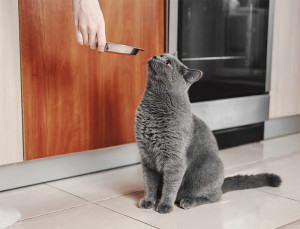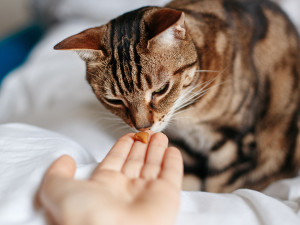Raw Food Diets for Cats: An Explainer
Cats are obligate carnivores — that we know. But do they need to eat like wild animals? We asked a holistic vet about the pros and cons of primal diets.
Close your eyes and try to envision your cat leaping into a tree and devouring an apple from a branch. Or prowling through the garden and pouncing on a head of lettuce. Can’t see it? Now, picture your cat catching a mouse and eating it whole. Actually, don’t picture that — too gruesome. But know that if your cat did catch and eat a mouse, it would kind of be an ideal meal. Why? Because cats are carnivores and they need meat. And according to some experts, raw meat is the way to go. Not convinced (or just grossed out)? We chatted with Dr. Judy Jasek, DVM, a holistic veterinarian from Animal Healing Artsopens in new tab in Colorado, to get the scoop on raw food diets for cats.
What’s the backstory on raw diets?
Many of the cats we know and love today demand their meals be served in just the right way at just the right time. And we oblige because, well, cats rule the roost. But undomesticated cats living in the wild didn’t have the luxury of a human at their beck and call. So they ate what they hunted and killed. Modern raw food diets are designed to mimic the way cats ate back in the day. They can consist entirely of raw meat, bones, and organs or be bolstered by whole fruits, vegetables, and natural supplements.
Save on the litter with color-changing tech that helps you better care for your cat.
But is raw food actually better?
Advocates of raw food diets believe they are a species-appropriate way to give your cat optimal nutrition. “Cats are obligate carnivores,” says Dr. Jasek. “There is no nutritional need for carbs in a cat’s diet, and their digestive systems aren’t equipped to break down vegetable matter the way that an herbivore’s is. Cats are meant to eat animal products, and a raw diet allows them to get nutrients from whole foods in a way that’s more bioavailable to them. On the other hand, kibble loses some nutritional value during processing and has to be supplemented with pre-mixed synthetic vitamins and minerals. Ultimately, we don't know how well cats can absorb those nutrients.”
Isn’t raw food dangerous?
All pet foods can contain harmful bacteria such as salmonella. Like kibble, commercially prepared raw diets undergo checks to ensure they’re safe and germ-free. Store-bought meat, however, can be a little riskier. “Meat sold at the grocery store is allowed to have more bacteria because it's assumed that it will be cooked before it’s eaten,” says Dr. Jasek. “If you want to purchase your own meat to feed your cat, I recommend going to a quality butcher that knows where the meat came from and how it’s been handled.” Proper sanitation is also important when feeding a raw diet. To keep you and your family members safe, thoroughly wash your hands and all surfaces, utensils, and dishes after feeding raw food. And make sure to follow guidelines opens in new tab for storing raw food.
How much do you spend on your pet per year?
So what should I look for in a raw food diet?
When selecting any pet food provider, you want to be sure you’re dealing with a reputable brand. The company should be upfront about its ingredients, which will ideally come from free-range, grass-fed animals that are humanely raised. Avoid any chemical additives and, according to Dr. Jasek, look for diets containing fresh sardines or mackerel rather than fish oil. Another factor to be aware of is that many raw foods found in pet stores use a process called high-pressure pasteurization (HPP). HPP is designed to kill potential pathogens but may also reduce some of the benefits of true raw food.
Say I wanted to switch my cat to a raw diet. How could I ensure a smooth transition?
Dr. Jasek recommends patience during the transition from kibble to raw. “Kibble is high in carbohydrates, and cats can get a little addicted to those,” she says. “Rather than free feeding, getting cats on an eating schedule so they’re a little hungrier at mealtime can be helpful when switching from kibble to raw. Some cats who have a weak digestive system or a history of vomiting and diarrhea may have trouble adjusting to a raw diet. In those instances, dehydrated or freeze-dried diets may be a little easier for them to digest at first. Then, once their gut is healthy, they can make the move to fresh raw diets.”
Your cat already thinks they’re the king of the urban jungle, so feeding them a raw meat diet might not be such a wild idea after all. But not all cats are the same — and not all vets advocate for raw feeding — so talk to your vet before making the switch.
Disclaimer alert: This article is here to share information. But, much like pineapple on pizza, the topic may be controversial. Meaning, not all vets or pet professionals agree. Because every pet is a unique weirdo with specific needs. So, don’t take this as fact or medical advice. Talk things over with your vet when making decisions, and use your best judgment (about both your pet’s health and pizza toppings).





